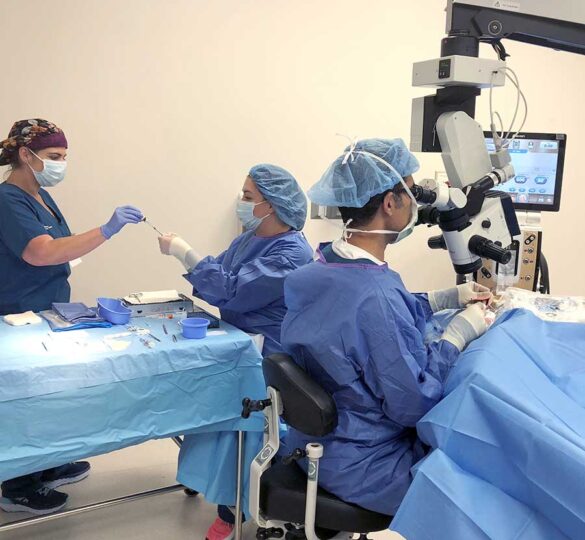MIGS: The New Age of Glaucoma Surgery
Over the past 5-10 years there has been a revolution in glaucoma surgery, specifically Micro-Invasive Glaucoma Surgery, commonly called MIGS.

In recent years there has been a revolution in glaucoma surgery, specifically Micro-Invasive Glaucoma Surgery, or MIGS.
Glaucoma is a disease where the optic nerve gets damaged and the main risk factor is elevated eye pressure (also called intraocular pressure, IOP). The only treatment is to lower the IOP.
I often think of the inside of the eye like a drain and a faucet, and using this analogy, high IOP is related to an imbalance between the amount of fluid made inside the eye and the amount of fluid the eye can drain. This fluid is called the aqueous and when we consider various treatment options to lower IOP, we can either decrease the amount of aqueous the eye makes or increase the drainage of aqueous from inside the eye. This goal can be accomplished with medications, laser, or surgery.
The traditional glaucoma surgeries (trabeculectomy and glaucoma drainage devices), while very effective, are associated with risks such as double vision, devastating eye infections, exposure of a drainage implant, swelling of the cornea, and excessively low IOP. Although these risks are relatively infrequent, they make most surgeons delay glaucoma surgery until all other less invasive treatment options are maximized (medications and laser treatment) and the patient has definitive glaucoma worsening.
Fortunately, the MIGS revolution has allowed us to change our approach to surgical glaucoma for many patients. The main theme and priority of MIGS is patient safety. While no surgery is without risk, MIGS provide improved safety while usually providing mild-to-moderate IOP lowering.
Categories of MIGS Procedures
MIGS can be thought of in a few broad categories, either enhancing fluid outflow using the eye’s inherent drainage system (GATT, Kahook Dual Blade Goniotomy, Trabectome, iStent), shunting fluid to the outside of the eye (XEN Gel Stent) or decreasing production of fluid within the eye (ECP). Some types of MIGS procedures are FDA approved to be performed only in conjunction with cataract surgery (iStent) whereas other MIGS procedures are approved to be performed independent of cataract surgery (GATT, goniotomy, Trabectome, XEN Gel Stent, and ECP).
While MIGS procedures will not replace or eliminate traditional glaucoma surgery, they have greatly decreased the number of patients who require these more invasive surgeries to control their IOP. Moreover, MIGS procedures have allowed us to have a lower threshold for a surgical intervention with the goal of providing better IOP control while decreasing a patient’s glaucoma medication burden.
Concerns about MIGS Procedures
There are without question, concerns about MIGS procedures. The first concern pertains to efficacy. While some types of MIGS provide a very modest IOP lowering, other MIGS procedures have demonstrated sustained and significant IOP lowering. Typically, MIGS procedures that are more effective at lowering the IOP are also associated with a slightly longer time to visual recovery. The second concern pertains to the cost and insurance coverage of these newer devices. The third concern is that some risks may not be fully understood until we have more data and longer follow-up on these procedures.
The goal of the new age of glaucoma surgery is to improve safety while tailoring the surgery to the individual patient’s disease stage and lifestyle. As a community, eye doctors need to continue to innovate and study outcomes for these procedures so we can maximize the efficacy and safety of glaucoma surgeries. Only time, experience, and careful studies will tell us which of these procedures will work best with which types of glaucoma patients.
Key to Abbreviations
ECP = Endoscopic Cyclophotocoagulation (an alternative laser procedure)
GATT = Gonioscopy-Assisted Transluminal Trabeculotomy
IOP = Intraocular Pressure
MIGS = Micro (or Minimally) Invasive Glaucoma Surgery
Article by Davinder S. Grover, MD, MPH. Posted on September 15, 2018. Last reviewed on March 9, 2022.

Davinder S. Grover, MD, MPH
Dr. Grover is a glaucoma, cataract, and anterior segment surgeon and serves as the Director of Clinical Research at Glaucoma Associates of Texas. He is passionate about improving the lives of patients through advanced treatments and innovative surgical techniques.